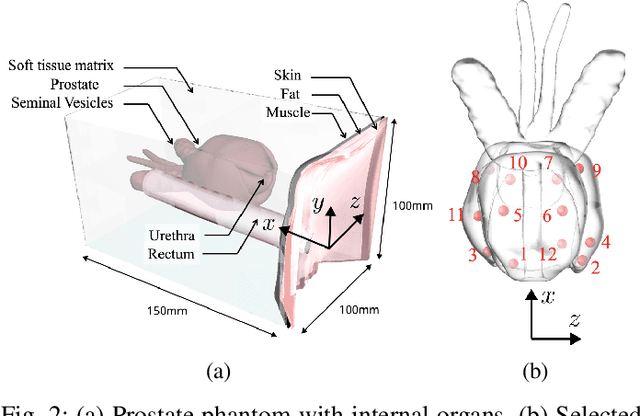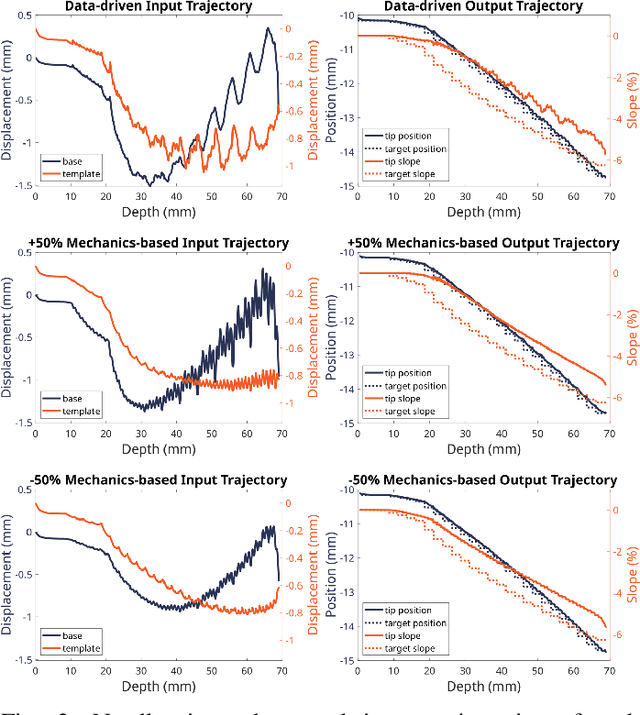Junichi Tokuda
Shape Manipulation of Bevel-Tip Needles for Prostate Biopsy Procedures: A Comparison of Two Resolved-Rate Controllers
Feb 05, 2024



Abstract:Prostate cancer diagnosis continues to encounter challenges, often due to imprecise needle placement in standard biopsies. Several control strategies have been developed to compensate for needle tip prediction inaccuracies, however none were compared against each other, and it is unclear whether any of them can be safely and universally applied in clinical settings. This paper compares the performance of two resolved-rate controllers, derived from a mechanics-based and a data-driven approach, for bevel-tip needle control using needle shape manipulation through a template. We demonstrate for a simulated 12-core biopsy procedure under model parameter uncertainty that the mechanics-based controller can better reach desired targets when only the final goal configuration is presented even with uncertainty on model parameters estimation, and that providing a feasible needle path is crucial in ensuring safe surgical outcomes when either controller is used for needle shape manipulation.
MR-conditional Robotic Actuation of Concentric Tendon-Driven Cardiac Catheters
Dec 07, 2023Abstract:Atrial fibrillation (AF) and ventricular tachycardia (VT) are two of the sustained arrhythmias that significantly affect the quality of life of patients. Treatment of AF and VT often requires radiofrequency ablation of heart tissues using an ablation catheter. Recent progress in ablation therapy leverages magnetic resonance imaging (MRI) for higher contrast visual feedback, and additionally utilizes a guiding sheath with an actively deflectable tip to improve the dexterity of the catheter inside the heart. This paper presents the design and validation of an MR-conditional robotic module for automated actuation of both the ablation catheter and the sheath. The robotic module features a compact design for improved accessibility inside the MR scanner bore and is driven by piezoelectric motors to ensure MR-conditionality. The combined catheter-sheath mechanism is essentially a concentric tendon-driven continuum robot and its kinematics is modeled by the constant curvature model for closed-loop position control. Path following experiments were conducted to validate the actuation module and control scheme, achieving < 2 mm average tip position error.
Bevel-Tip Needle Deflection Modeling, Simulation, and Validation in Multi-Layer Tissues
Nov 29, 2023Abstract:Percutaneous needle insertions are commonly performed for diagnostic and therapeutic purposes as an effective alternative to more invasive surgical procedures. However, the outcome of needle-based approaches relies heavily on the accuracy of needle placement, which remains a challenge even with robot assistance and medical imaging guidance due to needle deflection caused by contact with soft tissues. In this paper, we present a novel mechanics-based 2D bevel-tip needle model that can account for the effect of nonlinear strain-dependent behavior of biological soft tissues under compression. Real-time finite element simulation allows multiple control inputs along the length of the needle with full three-degree-of-freedom (DOF) planar needle motions. Cross-validation studies using custom-designed multi-layer tissue phantoms as well as heterogeneous chicken breast tissues result in less than 1mm in-plane errors for insertions reaching depths of up to 61 mm, demonstrating the validity and generalizability of the proposed method.
 Add to Chrome
Add to Chrome Add to Firefox
Add to Firefox Add to Edge
Add to Edge